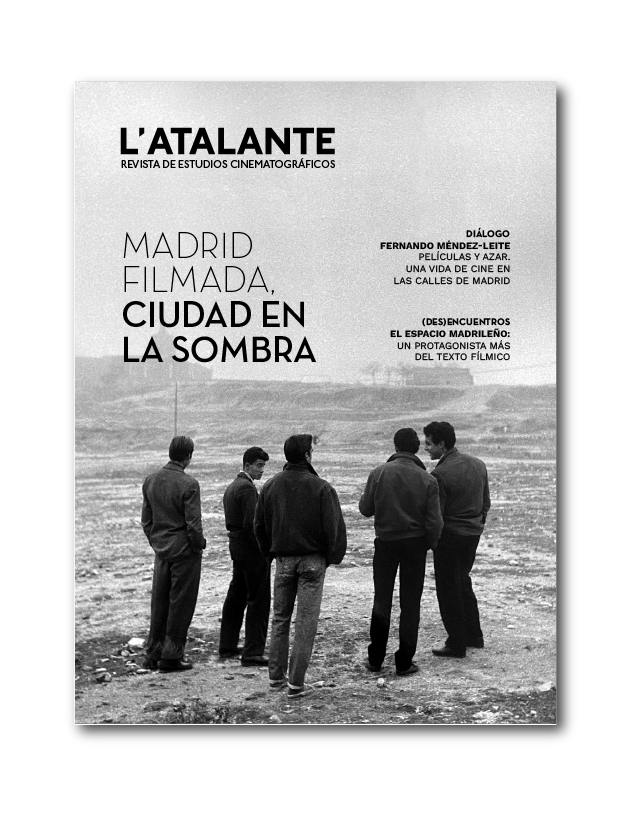Contrapuntos de Madrid: desarrollismo y polémica en el documental institucional de interés turístico durante el boom
Publicado 31.07.2023
Palabras clave
- Documental,
- Madrid,
- Boom turístico,
- Desarrollismo,
- Casticismo
Cómo citar
Derechos de autor 2023 L'Atalante. Revista de estudios cinematográficos

Esta obra está bajo una licencia internacional Creative Commons Atribución-NoComercial-SinDerivadas 4.0.
Resumen
In the 1950s, the General Directorate of Tourism began systematically using short documentaries for tourist promotion purposes. The image of Madrid in these films soon left behind the traditional nativist stereotypes of Spain characteristic of the first half of the decade to embrace the icons, discourses and notions of developmentalism, as was the case in Spanish fiction films. This article analyses the first two documentaries about the Spanish capital that were widely used by the tourist authorities, Contrapunto de Madrid (José López Clemente, 1957) and Sobre Madrid (Jorge Grau, 1960) with the aim of identifying the official stance in relation to this change (promoters, beneficiaries, opponents, etc.). In addition to a discursive analysis of the films, the article presents a pragmatic study of the documentaries, considering how they were used and the reasons for their production, as well as a contextual analysis, which seeks to explain the terms of the controversy that led to the withdrawal of more traditional iconographies and discourses of Madrid in tourism promotion.
Descargas
Citas
- Arocena Badillos, C. (2005). Luces y sombras. Los largos años cincuenta (1951-1962). En Castro de Paz, Pérez Perucha y Zunzunegui (eds.), La nueva memoria: historia(s) del cine español (1939-2000) (pp. 78-129). A Coruña: Vía Láctea.
- Aubert, J.P. (2013). Madrid à l’écran (1939-2000). París: Presses Universitaires de France.
- Casetti, F. y Di Chio, F. (2007). Cómo analizar un film. Barcelona: Paidós
- Crumbaugh, J. (2010). Destination: Dictatorship. The Spectacle of Spain’s Tourist Boom and the Reinvention of Difference. Albany: State University of New York Press.
- Castro de Paz, J.L. (2020) Un nuevo canon para el cine español: trayectorias históricas, sabores textuales. Archivos de la filmoteca: revista de estudios históricos sobre la imagen, 78, 49-62.
- Cerdán, J. y Castro de Paz, J.L. (2011). Del sainete al esperpento. Relecturas del cine español de los años cincuenta. Madrid: Cátedra.
- Del Rey Reguillo, A. (ed.) (2021a). La huella del turismo en un siglo de cine español (1916-2015). Madrid: Síntesis.
- Del Rey Reguillo, A. (2021b). El turismo en el cine del primer franquismo (1939-1958). En del Rey Reguillo (ed.), La huella del turismo en un siglo de cine español (1916-2015) (pp. 143-161). Madrid: Síntesis.
- Del Rey Reguillo, A. (2021c). El viaje de novios, un cliché argumental del cine turístico español de posguerra. En Villaverde y Galant (eds.), ¿El turismo es un gran invento? Usos políticos, identitarios y culturales del turismo en España (pp. 111-133). Valencia: Institució Alfons el Magnànim.
- Del Valle Fernández, R. (ed.) (1962). Anuario español de cinematografía (1955-1962). Madrid: Sindicato Nacional del Espectáculo.
- Deltell, L. (2006). Madrid en el cine de la década de los cincuenta. Madrid: Ayuntamiento de Madrid.
- Elsaesser, T. (2009). Archives and Archaeologies. The Place of Non-Fiction Film in Contemporary Media. En Hediger y Vonderau (eds.), Films That Work. Industrial Film and the Productivity of Media (pp. 19-34). Ámsterdam: Amsterdam University Press.
- Fuentes Vega, A. (2017). Bienvenido, Mr. Turismo: Cultura visual del «boom» en España. Madrid: Cátedra.
- Gil Vázquez, A. (2017) Arniches va al cine: conservadurismo y elementos disruptivos en la comedia asainetada Así es Madrid (Marquina, 1953). Cuadernos de Aleph, 9, 61-77.
- Grijalba de la Calle, N. (2016). La imagen de Madrid en el cine español. Madrid: Universidad Complutense de Madrid [Tesis doctoral].
- Hediger, V. y Vonderau, P. (2009). Record, Rhetoric, Rationalization. Industrial Organization and Film. En Hediger y Vonderau (eds.), Films that work. Industrial film and the productivity of media (pp. 35-50). Ámsterdam: Amsterdam University Press.
- Lázaro Sebastián, F.J. y Sanz Ferreruela, F. (2010). Goya en el cine documental español entre las décadas de los cuarenta y los ochenta: tratamientos sociológicos, ideológicos y estéticos. Artigrama: Revista del Departamento de Historia del Arte de la Universidad de Zaragoza, 25, 185-208.
- Matud Juristo, A. (2007). El cine documental de NO-DO. Madrid: Universidad Complutense de Madrid [Tesis doctoral].
- Monterde, J.E. (2006). Del neorrealismo y el cine español. En Nieto y Company (eds.), Por un cine de lo real: cincuenta años después de las Conversaciones de Salamanca (pp. 51-60). Valencia: La Filmoteca.
- Moreno Garrido, A. (2007). Historia del turismo en España en el siglo XX. Madrid: Síntesis.
- Plantinga, C. (2014). Retórica y representación en el cine de no ficción. México: Universidad Nacional Autónoma de México.
- Sanz Ferreruela, F. y Lázaro Sebastián, F.J. (2013). El desarrollo urbanístico como expresión de modernidad en el género cinematográfico documental del tardofranquismo. Arte y Ciudad: Revista de Investigación, 3, 69-84. http://dx.doi.org/10.22530/ayc.2013.N3.1.269
- Soto Vázquez, B. (2022). Un proyecto de construcción de imagen cinematográfica de España (1923-1929): de la propaganda turística al catálogo patrimonial. En Cánovas y Aliaga (eds.), El documental de arte en España (pp. 19-29). Madrid: Akal.
- Tranche, R. y Sánchez-Biosca, V. (2000). NO-DO: el tiempo y la memoria. Madrid: Cátedra.
- Zunzunegui, Santos (2018). Historias de España. De qué hablamos cuando hablamos de cine español. Valencia: Shangrila.

